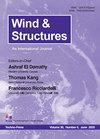Aerodynamic modifications for reduction of wind loads oncross plan shaped tall building
IF 1.9
4区 工程技术
Q3 CONSTRUCTION & BUILDING TECHNOLOGY
引用次数: 0
Abstract
Corner modification plays an essential role in the reduction of the wind load and responses on tall buildings. The present study investigates the effectiveness of different corner modifications (chamfered, rounded, and recessed corners) to reduce the wind load on regular cross plan shaped tall buildings using the computation fluid dynamics technique. Here, ANSYS CFX is used to simulate the boundary layer wind environment around the building and compared with experimental results. The numerically simulated data are compared with some previous wind tunnel test data on the '+' plan building. Based on the numerical study, flow pattern near the corner regions, pressure contour, the variation of pressure coefficient along the periphery of the building, force and moment coefficients for three corner modified models are analyzed and compared with sharp edged cross plan shaped model to comprehend the extent of nonconformities due to corner modifications. The rounded corner modification is most effective in suppressing the wind load compared to chamfered and recessed corners. For rounded corners with 50% corner cut, the reduction in force and moment coefficients is substantial, with up to 26.26% and 28.58%, respectively, compared to sharp edged corners. A sudden shoot up in the negative Cp values near edges of the corner modified model, should require special attention in the design of cladding components. This paper led to comprehend the wind-induced responses of cross plan shaped building with various corner configurations.降低平面交叉型高层建筑风荷载的气动修正
转角改造在降低高层建筑的风荷载和响应方面起着至关重要的作用。本研究使用计算流体动力学技术研究了不同转角修改(倒角、圆角和凹角)以降低规则十字形高层建筑的风荷载的有效性。本文利用ANSYS CFX软件对建筑物周围的边界层风环境进行了模拟,并与实验结果进行了比较。将数值模拟数据与“+”计划建筑上以前的一些风洞试验数据进行了比较。在数值研究的基础上,分析了三角修正模型的角区附近的流型、压力等值线、压力系数沿建筑物周边的变化、力和力矩系数,并与锐边十字平面模型进行了比较,以了解由于角部修正引起的不符合程度。与倒角和凹角相比,圆角修改在抑制风荷载方面最有效。对于切角量为50%的圆角,与锐边角相比,力和力矩系数的降低幅度很大,分别高达26.26%和28.58%。在包层组件的设计中,应特别注意角修正模型边缘附近的负Cp值突然升高。本文旨在了解具有不同转角配置的十字形建筑的风致响应。
本文章由计算机程序翻译,如有差异,请以英文原文为准。
求助全文
约1分钟内获得全文
求助全文
来源期刊

Wind and Structures
工程技术-工程:土木
CiteScore
2.70
自引率
18.80%
发文量
0
审稿时长
>12 weeks
期刊介绍:
The WIND AND STRUCTURES, An International Journal, aims at: - Major publication channel for research in the general area of wind and structural engineering, - Wider distribution at more affordable subscription rates; - Faster reviewing and publication for manuscripts submitted.
The main theme of the Journal is the wind effects on structures. Areas covered by the journal include:
Wind loads and structural response,
Bluff-body aerodynamics,
Computational method,
Wind tunnel modeling,
Local wind environment,
Codes and regulations,
Wind effects on large scale structures.
 求助内容:
求助内容: 应助结果提醒方式:
应助结果提醒方式:


